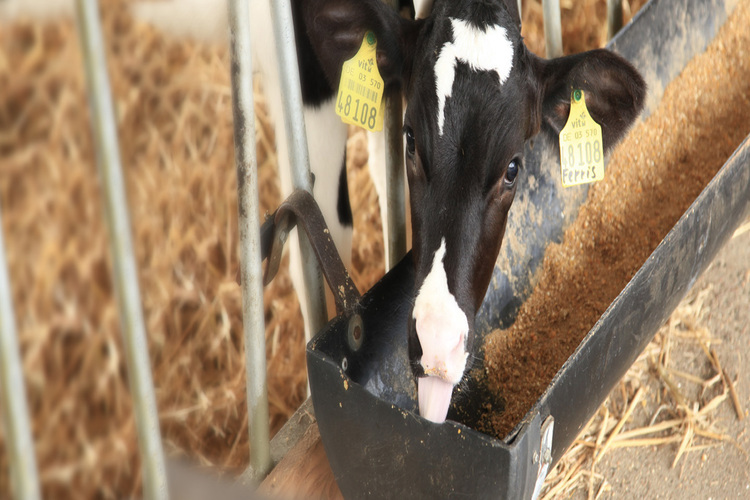Key takeaways from the research:
-
Additional growth in calves on an intensive feeding schedule is correlated with improved health parameters
-
Calves with a higher average daily gain as a result of an intensive calf feeding schedule calve earlier as a result of a better fertility

Pre and post-weaning growth as a result of Lifestart feeding schedules will improve future growth and health
Research has shown that the quality of nutrition has a strong influence on the pre-weaning growth[1,2,3,4,5,6,7,8,9] of dairy calves. As a result, the age at which heifers can be inseminated for the 1st time will go down[6,10]. Dr Ariane Bolt[11] studied the effect of pre-weaning and post-weaning growth in the first year of life on future performance.
Study design
A group of 1,435 calves fed intensively in the period up to weaning at day 63 was divided into a group of animals that had an average daily growth of < 800 gram per day (moderate growth group) and a group of animals that grew > 800 grams per day (high growth group).
Results
Health
Calves in the high growth group had less diarrhoea (15.8% vs. 22.3%), less pneumonia (24.9% vs. 25.9%) and required fewer antibiotic treatments (35.4% vs. 40.7%). The high growth group did however have a higher percentage of umbilical infections (2.5 vs. 1.8%).
Fertility
The age at first insemination was 0.3 months lower in the high growth group (p=0.02), but there was no difference in the number of inseminations between the groups. Age at first calving was 0.5 months lower in the high growth group (p=0.05).
Production
Differences in production during the first and subsequent lactations were not found.
Conclusion
If calves on an intensive feeding schedule are divided into a group with a moderate growth level and a group with a high growth level, the calves with the better growth will have fewer disease problems and better fertility. Differences in milk production were not significant in this study.
References
[1] Shamay, A., D. Werner, U. Moallem, H. Barash, and I. Bruckental. 2005. Effect of nursing management and skeletal size at weaning on puberty, skeletal growth rate, and milk production during the first lactation of dairy heifers. J. Dairy Sci. 88:1460–1469.
[2] Faber, S. N., N. E. Faber, T. C. McCauley, and R. L. Ax. 2005. Case study: Effects of colostrum ingestion on lactational performance. Prof. Anim. Sci. 21:420–425.
[3] Morrison, S. J., H. C. F. Wicks, R. J. Fallon, J. Twigge, L. E. R. Dawson, A. R. G. Wylie, and A. F. Carson. 2009. Effects of feeding level and protein content of milk replacer on the performance of dairy herd replacements. Animal 3:1570–1579.
[4] Davis Rincker LE, VandeHaar MJ, Wolf CA, Liesman JS, Chapin LT and Weber Nielsen MS, Effect of intensified feeding of heifer calves on growth, pubertal age, calving age, milk yield, and economics. J. Dairy Sci 94:3554-3567 (2011).
[5] Moallem, U., D. Werner, H. Lehrer, M. Zachut, L. Livshitz, S. Yakoby, and A. Shamay. 2010. Long-term effects of ad libitum whole milk prior to weaning and prepubertal protein supplementation on skeletal growth rate and first-lactation milk production. J. Dairy Sci. 93:2639–2650.
[6] Raeth-Knight, M., H. Chester-Jones, S. Hayes, J. Linn, R. Larson, D. Ziegler, B. Ziegler, and N. Broadwater. 2009. Impact of conventional or intensive milk replacer programs on Holstein heifer performance through six months of age and during first lactation. J. Dairy Sci. 92:799–809.
[7] Drackley, J. K., B. C. Pollard, H. M. Dann, and J. A. Stamey. 2007. First-lactation milk production for cows fed control or intensifi ed milk replacer programs as calves. J. Dairy Sci. 90(Suppl. 1):614 (Abstr.).
[8] Terré, M., C. Tejero, and A. Bach. 2009. Long-term effects on heifer performance of an enhanced growth feeding programme applied during the pre-weaning period. J. Dairy Res. 76:331–339.
[9] Soberon F, Raffrenato E, Everett RW and Van Amburgh ME. 2012, Preweaning milk replacer intake and effects on long-term productivity of dairy calves. J. Dairy Sci 95:783-793.
[10] Bar-Peled et al., 1997. Increased weight gain and effects on production parameters of Holstein heifer calves that were allowed to suckle from birth to six weeks of age. J. Dairy Sci; 80:2523-8.
[11] Bolt, A. 2019, Meta-analysis to calculate the effect of rearing intensity on functionality of dairy cows, Research paper Mecklenburg Vorpommern Landesforschungsanstalt für Landwirtschaft und Fischerei.



